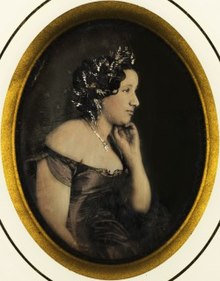Céleste Mogador
| Céleste Mogador | |
|---|---|
 |
|
| Born |
Élisabeth-Céleste Venard December 27, 1824 Paris, France |
| Died | February 18, 1909 (aged 84) Montmartre, France |
| Nationality | French |
Élisabeth-Céleste Venard (December 27, 1824 – February 18, 1909), better known by her stage name Céleste Mogador and often referred to simply as Mogador, was a French dancer and writer. She was also the countess of Chabrillan.
The daughter of Anne-Victoire Vénard, she was born in Paris, France, on December 27, 1824. Her father died when she was six; she was neglected by her mother and abused by her stepfather. At the age of sixteen, she began performing at the Cirque Olympique. She helped introduce dances such as the quadrille and the can-can at the Bal Mabille. She is credited with being the first to dance the schottische. She also sang in cabarets, performing songs by Sebastián Iradier. One source has suggested that the character Carmen in Bizet's opera of the same name may have been based on Mogador.
In 1854, she married Lionel de Moreton, count of Chabrillan. He was named consul for France in Melbourne, Australia, and died there in 1858. In 1854, she published a memoir Adieu au monde, Mémoires de Céleste Mogador. In 1877, she published Un deuil au bout du monde describing her experiences in Australia.
She was director of a theatre company, the Folies-Marigny. Mogador also wrote a number of plays, including Les voleurs d'or, Les Crimes de la mer, Les Revers de l'Amour, L'Américaine and Pierre Pascal. During the Franco-Prussian War, she established Les Soeurs de France to look after wounded soldiers and she opened her home to children orphaned during the war.
The name "Mogador" refers to the 1844 bombardment of Mogador in Morocco, now known as Essaouira.
Mogador wrote a series of novels:
...
Wikipedia
